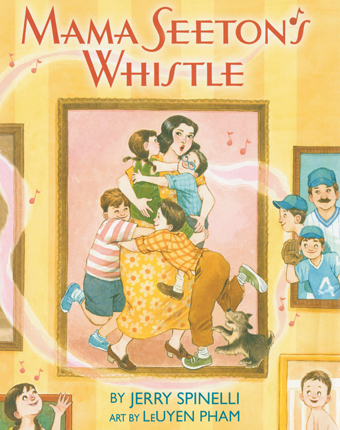Full Text Reviews: School Library Journal - 01/01/2015 PreS-Gr 2—When Mama Seeton whistles out the back door, her four children, three boys and a girl, always respond by dashing home for dinner and chocolate cake. But when they grow up and leave town, that whistle can no longer bring them home, and Mama Seeton misses them desperately. One day Papa encourages her to go outside and whistle, hoping the pretense will help, but it doesn't. However, though "no one has ever been able to explain" how it happened, each now-adult child hears the familiar sound and comes home, even from distant places. Now, following her example, Mama Seeton's children call their own offspring with a whistle as well. Mama is based on a neighbor from Spinelli's childhood, and the illustrations, executed in watercolor and ink, feature the cars, bikes, hair styles, clothing, and black-and-white TVs of his boyhood years. An especially effective spread depicting the various exploits of the children all across town conveys the passage of time with a display of all four seasons, beginning with the blossoms of spring on the left and moving across the page to summer greens, autumn colors, and finally, a snow-covered hillside on the right. A wavy pink line swirls throughout the pages connecting mom and children, and alert readers will notice how the kids' childhood interests blossom into their adult pursuits. Author and illustrator notes complete this nostalgic look at the enduring love between a mother and her children.—Marianne Saccardi, Children's Literature Consultant, Greenwich, CT - Copyright 2015 Publishers Weekly, Library Journal and/or School Library Journal used with permission. Booklist - 03/01/2015 *Starred Review* When the story begins, in the 1950s, Mama Seeton can’t find her toddler, Skippy. Without thinking, she produces a two-note whistle that also produces Skippy, who has been in the house the whole time. As Papa and Mama Seetons’ family grows—Sheldon, Stewart, and Sophie—the children become used to the whistle calling them home no matter how far in the neighborhood they roam, with their reward being some of Mama’s chocolate cake. Pham does a marvelous job of showing how time passes: fashions and neighborhoods change, children get older, and their activities become more challenging. Then one day all of them are grown and gone, leaving a lonely Mama Seeton, who now only makes the chocolate cake once a week. Papa has the idea of having her whistle once more, and with a bit of magical whimsy, the children, now scattered around the world, hear the two notes and come home for a visit. The story has the sentimental veneer that may initially appear to appeal more to the reader than the listener. But the story’s universal elements of love and family will warm even young readers. Adding greatly to the appeal is sprightly, often humorous artwork that features a Mama Seeton who, in the beginning, has more than a passing resemblance to Disney’s Snow White. Fun and memories mix here, delightfully demonstrating the old adage “there’s no place like home.” - Copyright 2015 Booklist. Bulletin for the Center... - 09/01/2015 “It was not a loud whistle. Or a fancy whistle. Just a simple, two-note whistle,” yet when Mama Seeton whistles it reaches the ears of her four children down the block, through the neighborhood, and across town, calling them home. After the children grow up and leave home for adventurous careers, Papa Seeton encourages his wife to try her whistle once more, and a bit of magic wafts her out-of-practice tune to her far-flung children, bringing them back for a much-needed visit. Spinelli sets his tender tribute to familial bonds square in mid-twentieth-century America, celebrating the era without getting bogged down in sentimentality and instead noting with gentle candor that the “old days became the new days” and “time went by, as time does.” Pham’s line and watercolor illustrations nicely support this clear-eyed look at the bittersweet passage of time; chipper vignettes are amusingly threaded together with the swelling red line of Mama’s whistle, with the occasional overhead perspective lacing the summoned together. Charming detail extends beautifully to the last scene, where the grown Seeton brood whistle for their own crew, which in modern America means more diverse but no less happy families. While the empty-nest trope will appeal to adults more than kids, youngsters will understand both the love and the silliness of a family call that reaches even adult children instantly, and the book may provide an opportunity for parents to put older family relationships into context. An author’s note explains the story is based on a real Mama Seeton with a real family-calling whistle. AA - Copyright 2015 The Board of Trustees of the University of Illinois. Loading...
|



